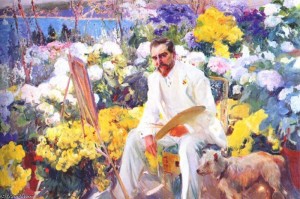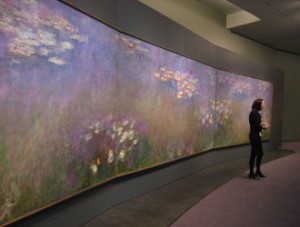Let’s continue the discussion about using some of the paintings in the Cleveland Museum of Art exhibition entitled Painting the Modern Garden: Monet to Matisse as a vehicle to relate what you see in some of the paintings to the principles of landscape design.
 Sorolla: Louis Comfort Tiffany (in Room 5)
Sorolla: Louis Comfort Tiffany (in Room 5)
Sorolla uses many aspects of the use of color to create rhythm, moving the eye through the painting. White, as an amalgam of all colors, is the strongest color and Sorolla uses the color echo of Tiffany’s white suit and the white hydrangeas to make Tiffany the focus of this portrait. Tiffany, after all, was his benefactor and patron.
In the design of the garden, a lot of strong yellow was used horizontally in the garden foreground, a tiny bit in the middle ground, and a vertical grouping in the background was used to balance the use of this color. Three shades of blue are found in the garden, the pale blue of hydrangeas, a medium blue and a violet blue (I was unable to identify those flowers). Blue is the hardest color to see in a background or in the distance but here we notice the darkest shade because it is directly behind Tiffany’s white suit. All of the blues are reinforced with the large area of blue water.
 Van Gogh: Daubigny’s Garden at Auvers (in Room 6)
Van Gogh: Daubigny’s Garden at Auvers (in Room 6)
This landscape is composed of lawn and island beds which can be quite problematic. One of the first things I noticed when I saw this painting was the awkward lawn lines. Curvilinear lines need to be large and sweeping to be effective. I also noticed that the shape of the island beds was most unusual; they look like peapods.
So often, there is one island bed, isolated somewhere in a lawn and it begs the question of why it is there. A sequence of island beds can be very attractive, particularly when their lines echo each other and when some of the plantings are repeated. Many of Daubigny’s beds repeated plantings with red flowers.
The best example of a series of island beds that I have ever seen was at Bressingham in England. The curvilinear lines of these large beds sweep and swoop and echo each other on facing sides. They are all connected with lawn as the path.
 Monet: Water Lilies Triptych (in Room 7)
Monet: Water Lilies Triptych (in Room 7)
This magnificent triptych is an excellent example of the maxim that the whole is greater than the sum of the parts. Each of the three large paintings is impressive and serene but this once-in-a-lifetime occasion that brings them together is an opportunity to experience, in Monet’s words, “the illusion of an endless whole”.
Many of us have landscapes that are full of disparate parts. The challenge of design is finding a way to relate them to each other in order to create unity.
 Matisse: Interior with Etruscan Vase (in Room 8
Matisse: Interior with Etruscan Vase (in Room 8
Both ornament and tropical plants are often incorporated into gardens to create focal points and a variety of textures as well additional color. Think of canna leaves. I have one client who loves orange and for her, we have planted the canna with dark bronze leaves and orange stripes. The foliage is much more important than the flowers. Happily, although tender, they are easy to overwinter as dormant plants. However, if there is space and light in your home, such tenders can be brought in to brighten your life during the winter. Who knows whether the tropicals in the painting had been in the garden earlier or were being treated as indoor plants all along.
Note that the plant on the left in the painting is a Monstera deliciosa, a variety of philodendron with huge, divided leaves. As I was writing this post and looking at a photo of the painting, I was suddenly struck by the fact that the cutouts used by Matisse, later in his life, for collages and stained glass design were portions of Monstera leaves.
In this painting, Matisse placed the large tropicals asymmetrically. Balance can, of course, be either symmetrical or assymetrical but assymetrical balance often has more impact.
The use of black in the landscape is problematic. Matisse used it as the tabletop and as part of the background but this is a color that disappears unless it is countered with hot colors. In the garden, a plant such as Ophiopogon planiscapus ‘Nigrescens’ will not be noticed unless it is planted into a grouping of a hot colored plant such as the yellow Creeping Jenny (Lysimachia nummularia ‘Aurea’).
I had a wonderful time giving my talk but my time was very limited. Now I’ve had time to expand a bit on what I said and, hopefully, you have found it illuminating. The exhibition will be at the museum until the beginning of January so make sure you find time to visit it.


2 Comments